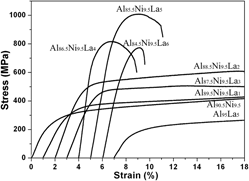Article contents
Synthesis of high strength aluminum alloys in the Al–Ni–La system
Published online by Cambridge University Press: 11 March 2014
Abstract

High strength aluminum (Al) alloys were prepared by rapid solidification method in the Al–Ni–La system. Microstructural characterizations show that all the investigated Al–Ni–La alloys are comprised of Al, rod-like Al3Ni, and blocky Al11La3 phases, of which the size and volume fraction are composition-dependent. The Al85.5Ni9.5La5 (at.%) alloy shows the finest microstructure, which contributes to the highest strength along with considerable plasticity. The experimental analysis and finite element simulation (FES) show that the distribution of the intermetallic phases greatly affects the mechanical properties of the alloys. The rod-like Al3Ni phase precipitated with the locally uniform direction prevents the propagation of cracks and benefits the plastic deformation, whereas the blocky Al11La3 phase exhibits the nature of brittleness and acts as the origin of the microcrack initiation. These findings suggest a new method to design high strength Al alloys.
- Type
- Articles
- Information
- Copyright
- Copyright © Materials Research Society 2014
References
REFERENCES
- 7
- Cited by




